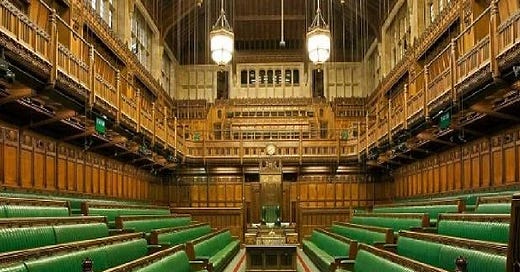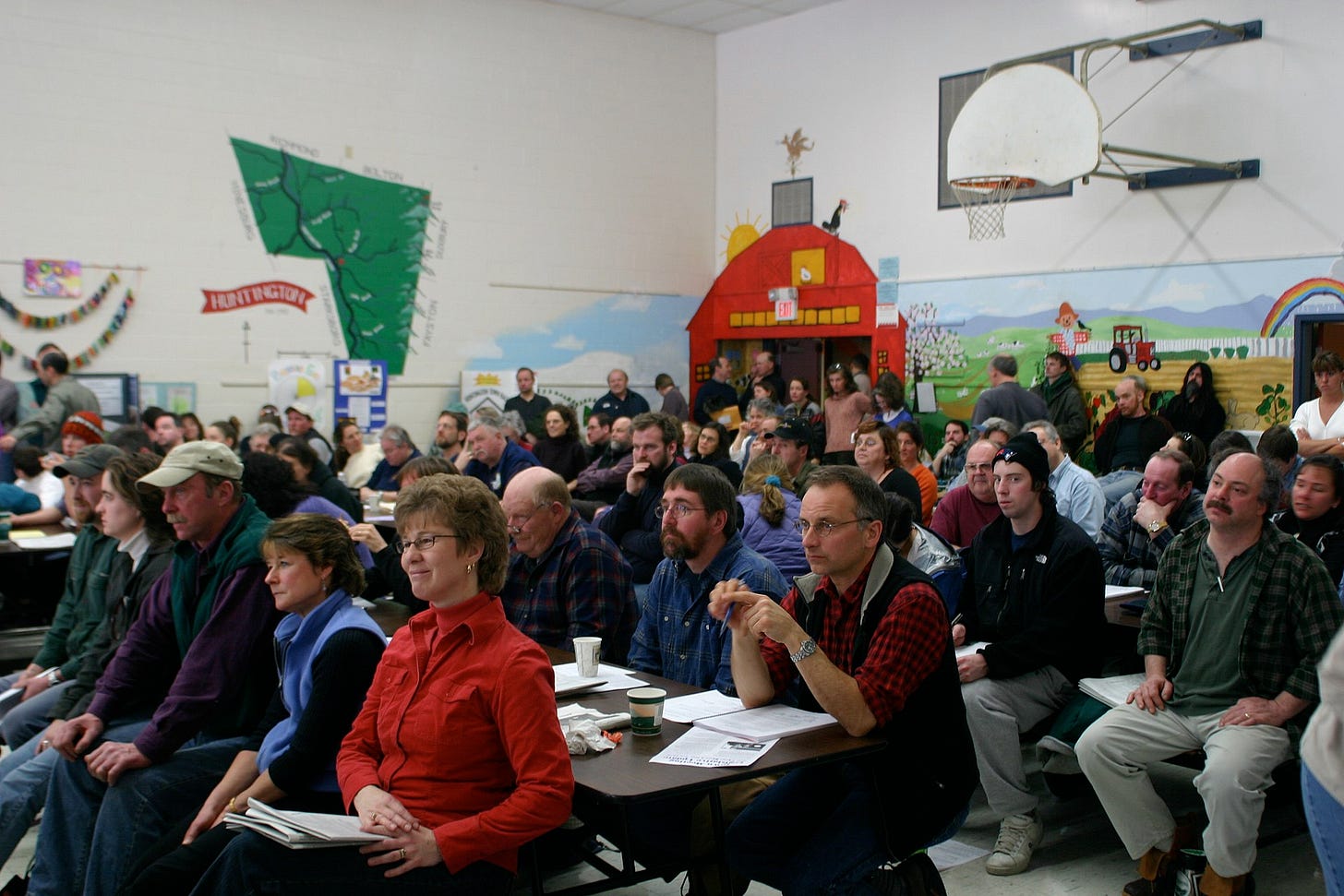Parliamentary and Town Meeting Roots
From "The Trouble With Elections: Everything We Thought We Knew About Democracy is Wrong," Chapter 6.5
Elected legislatures of today derive from repurposed chambers convened by monarchs to allow consultation with the aristocracy of the kingdom. They were not purpose-designed for democracy, and are ill-suited for that purpose. The common electoral chambers used today have their roots in medieval times. Many European kings convened bodies of nobles and religious leaders for consultation. The Estates General had been convened by French kings from time to time since the twelfth century. When convened by King Louis XVI to address a finance issue in 1789, however, it ended with the French Revolution, and the eventual replacement of the monarchy with an electoral oligarchy.
The evolution of similar bodies in England is particularly relevant to the transformative eighteenth century revolution in the United States. As far back as the eighth century Anglo-Saxon kings had regularly convened advisors and nobles in what was called the Witan. After the Norman conquest in the eleventh century, a similar advisory body, the commune concilium, eventually evolved into a parliament. While the Magna Carta at the beginning of the thirteenth century is often taught as being an important document in the history of “democracy,” it is more accurately viewed as formalizing power sharing and beginning the transition from pure monarchy to oligarchy. Elections of representatives to parliament from the landed aristocracy were added near the end of the thirteenth century, in what came to be known as the “model parliament.”. As I will discuss in a later section, the American revolutionaries used this parliamentary chamber model in designing their own legislatures, with the expressed purpose of empowering what framers such as James Madison called the “natural aristocracy” of America, as opposed to the hereditary aristocracy of Britain.
Origins of New England Town Meeting
New England Town Meeting is a long-standing democratic tradition, which continues to this day in many towns. Some municipalities have changed to the typical elected government with a nominal “town meeting” that simply refers to the election day for town officials, though there are some referendums on the ballot as well. Smaller towns often still have a day-long in-person annual meeting with an elected moderator, where budgets are set, and various local decisions are made by voice vote or show of hands (though the election of town officials is now conducted with paper ballots).
The origins of New England town meetings are not as most people would assume. A useful history was published in the Journal of Public Deliberation in 2019. Rather than harking back to Greek democracy, town meeting and representative government in New England, according to the foremost scholar of New England town meeting, Frank Bryan, of the University of Vermont, trace their origins back to stock-ownership corporations and religious congregations. The Massachusetts Bay Company, which established the colony, was an early “joint stock” corporation with investors, who elected their corporate officers. With the “great migration” of Puritans to New England in the first half of the seventeenth century, the annual corporate share-holders meeting was moved from England to the colony itself. Free men who passed a religious purity test were empowered to elect company officers, which was effectively the government of the colony. The well-known Mayflower Compact was a concrete example of a “social contract,” (which was merely a hypothetical concept in the writings of many Enlightenment political theorists) in which the adult free men committed to abide by majoritarian group decisions in the interests of survival in the new Plymouth colony. Other towns in New England were settled by groups who had also been granted corporate charters by the king. They would gather in Proprietors Meetings to decide issues related to establishing a new community.
The Puritans and other congregational-style churches rejected the more hierarchical structure of the Roman Catholic Church, or even the Anglican Church, which then dominated England, and held meetings of the entire (male) congregation to make certain decisions and elect officers. At the outset these were quasi-democratic “intentional communities” in which a social contract was real and expressed, rather than theoretical.
Since all of the residents of a given settlement in New England were initially members of a single church, it was natural to follow this model for their town government, in the form of town meeting. This assembly and the officials elected to run the church in the town might also be the town government (filling the vacuum created by the absence of any pre-existing municipal government), though many congregations distinguished between church and civil magistrates. These early “democracies” in America were corporate and religious in origin and theocratic in nature. Puritans of the Bay and Plymouth colonies had no tolerance for other Christian sects (let alone other religions). Quakers and members of other churches were often expelled. The Quakers who decamped to Rhode Island brought their congregation meeting style with them (and also, unusually, established a society that was tolerant of religious differences).
Each congregation was associated with, but independent from, fellow congregations in other towns. They had no hierarchy above the individual congregations. The Synod was a coordinating body of multiple churches for settling disputes, etc, but was not superior to the individual churches. The entire state of Connecticut was essentially a confederation of independent municipalities. The early Congregationalists in New England formalized their governance structure in a sort of constitution adopted in 1648 known as the Cambridge Platform.
In 1686, following the revocation of the Massachusetts Bay charter, King James II moved to organize the various English colonies from present day New York to Maine, which had been established under different charters, into one centralized “Dominion of New England,” with the goal of regulating trade, streamlining administration and increasing religious tolerance (a major focus of the Catholic King James II). The new Governor in Chief, Sir Edmund Andros, faced huge difficulties and resentments. For example, Andros had to lead a military force to Maine to stop English settlers there who had been raiding indigenous villages, taking captives and shipping them off to Boston. Local town meetings, in Maine, Connecticut and elsewhere became centers of protest against the Dominion government. Andros sought to limit town meetings. Then, with the dramatic 1688 removal of King James II back in England, the colonies seized the opportunity to restore their distinct systems of local government. Parliament’s effective coronation of the replacement king, William of Orange, in 1689, further shifted the center of power from the Crown, in the direction of the aristocratic parliament.
Over time, more and more responsibilities in New England were entrusted to elected boards of selectmen, who made decisions in between town meetings. Local town meetings, in which the citizens (at least those who choose to attend) serve as a limited local legislative body, persist in many smaller New England towns to this day. But there was not any inspiration from Greek democracy nor Roman republic. A few historians have even suggested that some of the Founders, like Jefferson and Franklin, may have taken more inspiration about popular consent and participation from the indigenous Iroquois Confederation than from Athens.






